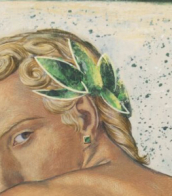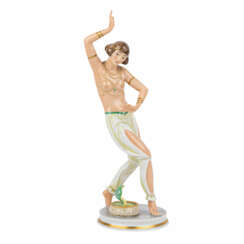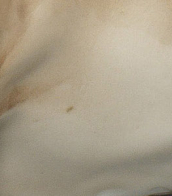gustav lange

Johann Gustav Lange was a 19th century German landscape painter.


Johann Gustav Lange was a 19th century German landscape painter.


Gustave Clarence Rodolphe Boulanger was a French painter renowned for his classical and Orientalist themes. He was born in Paris and became an accomplished academic artist, earning accolades such as the Prix de Rome in 1849.
Gustave Boulanger's paintings often focused on historical subjects, with influences from Greek and Roman mythology, as well as Orientalism, particularly Middle Eastern themes. He also depicted scenes of daily life in ancient civilizations and had a knack for blending the ancient with the modern. Notable works by Boulanger include "Répétition théâtrale dans la maison d’un poète romain" (1855), presented at the Salon of 1855, which later inspired the Pompeiian palace inauguration. His style was known for its theatricality and ability to bridge the past with contemporary aesthetics.
Some of his significant works are housed in various museums and galleries, including the British Museum, the Art Institute of Chicago, and the Hermitage Museum. Examples of his works include "The Flute Concert," "The Slave Market," and "Theatrical Rehearsal in the House of an Ancient Roman Poet".
Gustave Boulanger also played a role in the cultural landscape of his time, teaching at the Académie Julian, where he influenced a generation of artists. His contributions to art and his ability to capture the spirit of different eras continue to be celebrated by collectors and experts in art and antiques.
If you are interested in updates on Gustave Boulanger-related auctions and sales, consider subscribing to a newsletter that provides such information. This subscription is designed solely for alerting you to new product sales and auction events related to Boulanger's work, without any additional promotional content.


Gustave Clarence Rodolphe Boulanger was a French painter renowned for his classical and Orientalist themes. He was born in Paris and became an accomplished academic artist, earning accolades such as the Prix de Rome in 1849.
Gustave Boulanger's paintings often focused on historical subjects, with influences from Greek and Roman mythology, as well as Orientalism, particularly Middle Eastern themes. He also depicted scenes of daily life in ancient civilizations and had a knack for blending the ancient with the modern. Notable works by Boulanger include "Répétition théâtrale dans la maison d’un poète romain" (1855), presented at the Salon of 1855, which later inspired the Pompeiian palace inauguration. His style was known for its theatricality and ability to bridge the past with contemporary aesthetics.
Some of his significant works are housed in various museums and galleries, including the British Museum, the Art Institute of Chicago, and the Hermitage Museum. Examples of his works include "The Flute Concert," "The Slave Market," and "Theatrical Rehearsal in the House of an Ancient Roman Poet".
Gustave Boulanger also played a role in the cultural landscape of his time, teaching at the Académie Julian, where he influenced a generation of artists. His contributions to art and his ability to capture the spirit of different eras continue to be celebrated by collectors and experts in art and antiques.
If you are interested in updates on Gustave Boulanger-related auctions and sales, consider subscribing to a newsletter that provides such information. This subscription is designed solely for alerting you to new product sales and auction events related to Boulanger's work, without any additional promotional content.




Gustave Clarence Rodolphe Boulanger was a French painter renowned for his classical and Orientalist themes. He was born in Paris and became an accomplished academic artist, earning accolades such as the Prix de Rome in 1849.
Gustave Boulanger's paintings often focused on historical subjects, with influences from Greek and Roman mythology, as well as Orientalism, particularly Middle Eastern themes. He also depicted scenes of daily life in ancient civilizations and had a knack for blending the ancient with the modern. Notable works by Boulanger include "Répétition théâtrale dans la maison d’un poète romain" (1855), presented at the Salon of 1855, which later inspired the Pompeiian palace inauguration. His style was known for its theatricality and ability to bridge the past with contemporary aesthetics.
Some of his significant works are housed in various museums and galleries, including the British Museum, the Art Institute of Chicago, and the Hermitage Museum. Examples of his works include "The Flute Concert," "The Slave Market," and "Theatrical Rehearsal in the House of an Ancient Roman Poet".
Gustave Boulanger also played a role in the cultural landscape of his time, teaching at the Académie Julian, where he influenced a generation of artists. His contributions to art and his ability to capture the spirit of different eras continue to be celebrated by collectors and experts in art and antiques.
If you are interested in updates on Gustave Boulanger-related auctions and sales, consider subscribing to a newsletter that provides such information. This subscription is designed solely for alerting you to new product sales and auction events related to Boulanger's work, without any additional promotional content.


Gustave Camille Gaston Cariot was a French painter. He was known for his Impressionist-style paintings of landscapes, still lifes, and portraits.
Cariot studied at the École des Beaux-Arts in Paris, where he was influenced by the Impressionists and Post-Impressionists. He exhibited his work at the Salon des Artistes Français and the Salon d'Automne, and won several awards and honors throughout his career.
Cariot's paintings are characterized by their use of light and color, with loose brushstrokes and a vibrant palette. His landscapes often depicted scenes of the French countryside, particularly the forests and rivers of the Fontainebleau region. His still lifes featured flowers, fruit, and other objects arranged in simple yet elegant compositions.
In addition to his paintings, Cariot also worked as an illustrator, creating illustrations for books and magazines. He illustrated the works of Émile Zola, Paul Verlaine, and other writers.
His paintings are held in the collections of many museums and galleries, including the Musée d'Orsay in Paris and the National Gallery of Art in Washington, D.C.


















































































